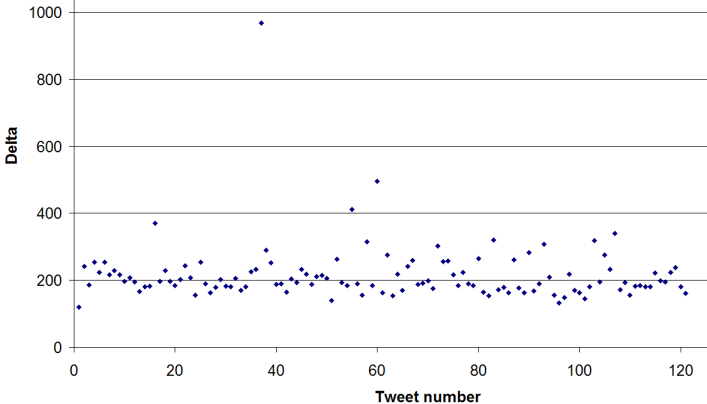Yesterday Mark Reid
posted on
Twitter
a challenge:
create a self-referential tweet (one that links to itself).
He later
clarified that the
tweet should contain in its text its own identifier
(the number after "
By looking through the URLs of a few tweets I realized that the identifier was increasing over time, so I wrote a script to rapidly post tweets with the appropriate identifier in them. The first version of the script was a failure, but it allowed me to collect a sequence of successive tweet identifiers. It turned out that about one to two hundred other tweets were being posted between each of my script's tweets, thus hardening the guess for the next tweet identifier. With the identifiers in a spreadsheet I could safely experiment with various strategies without the risk of getting locked out of Twitter due to rapid tweeting.
My first attempt was a Newton-Raphson style approximation. If delta is the identifier difference between two tweets and error is the difference between the guessed identifier and the next one, I let the next guess be
lastId + delta + error / 2This formula rapidly converged toward a small error, but failed to hit the nail.
Another attempt took a second derivative delta2 as the difference between two delta values and had the next guess be
lastId + delta + delta2This also failed to predict an id value for the identifiers I had collected.
At that point I decided to look at the distribution of the delta
values.

As you can see, there is a slight oscillation in the deltas,
but this is not always discernable from one value to the next.
Therefore, my next try was simpler, rather than more complicated. I had guess be
lastId + deltaand hoped that raw power and chance would hit the correct result. Indeed, looking at the mean squared error of the three estimations I saw that the last and simplest formula had the lowest error value. This reminded me of Anatol Rapaport's simple tit-for-tat strategy which famously won in an iterated prisoner's dilemma tournament although it was the simplest of all programs entered.
I implemented the formula (as I had the initial one) in a simple shell script. Thankfully, I could easilly invoke Twitter's API just by executing curl with the appropriate arguments.
#!/bin/sh
#
# Create a self-referential tweet
# Diomidis Spinellis, August 2009
#
# Post a self-referential entry and return its id
getid()
{
curl -s -u SelfRefer:$PASSWORD \
-d "status=Self referential tweet http://twitter.com/SelfRefer/status/$selfid" \
http://twitter.com/statuses/update.xml |
sed -n '/<id>/{;s/.*<id>\([^<]*\)<\/id>.*/\1/p;q;}'
}
# Initial values
selfid=3125051561
delta=120
oldid=$selfid
error=0
while :
do
id=`getid`
delta=`expr $id - $oldid`
oldid=$id
selfid=`expr $id + $delta`
error=`expr $id - $selfid`
echo "id=$id error=$error delta=$delta selfid=$selfid"
if [ $error -eq 0 ]
then
# Delete other entries
while read id
do
curl -s -u SelfRefer:$PASSWORD --http-request DELETE \
http://twitter.com/statuses/destroy/$id.xml >/dev/null
done <todelete
# Success; done
exit 0
fi
echo $id >>todelete
done
Why I Choose Email Over Messaging (2025-09-26)
Is it legal to use copyrighted works to train LLMs? (2025-06-26)
I'm removing the BSD advertising clause (2025-05-20)
The perils of GenAI student submissions (2025-04-11)
Unix make vs Apache Airflow (2024-10-15)
How (and how not) to present related work (2024-08-05)
An exception handling revelation (2024-02-05)
Extending the life of TomTom wearables (2023-09-01)
How AGI can conquer the world and what to do about it (2023-04-13)
Last modified: Wednesday, August 5, 2009 12:29 am
Unless otherwise expressly stated, all original material on this page created by Diomidis Spinellis is licensed under a Creative Commons Attribution-NonCommercial 4.0 International License.




